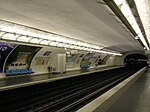The massacre of 14 July 1953 in Paris was an event in which the French police intentionally and without warning opened fire, causing 7 deaths (six Algerians and one French). and hospitalizing around 60 protesters and police officers. The incident occurred at the end of a parade organized by the French Communist Party (PCF) and the General Confederation of Labour (CGT) to celebrate the "values of the Republic" on the occasion of the French national holiday. It is part of the "massacres in Paris," including the massacre on 6 February 1934 (15 deaths), the massacre on 17 October 1961 (between 7 and over 200 deaths, according to different estimates), and the massacre at Charonne subway (9 deaths on 8 February 1962).
Between 10,000 and 15,000 people marched in the streets on 14 July 1953, with half of them being part of a significant Algerian procession of 6,000 to 8,000 individuals led by the Movement for the Triumph of Democratic Liberties (MTLD). Up until that point, the parade had been peaceful, but tragedy struck when the last protesters reached Place de la Nation. Within a few minutes, dozens of shots were fired at the MTLD procession.
In the aftermath of the massacre, for 14 years, the authorities banned demonstrations on May 1st and July 14th, until the 1 May 1968 parade. This event also marked the end of popular parades organized during the national holiday in the capital.
This tragedy, amid the repression of Algerian nationalism and serious events in Morocco and Tunisia, occurred less than a year after the announcement of independence for these two countries and a little over a year before the start of the Algerian War on 1 November 1954.
It wasn't until the early 2000s that the first books entirely devoted to this event appeared, and it was not until the commemoration of the 64th anniversary of the demonstration in 2017 that the Paris City Hall made the first official recognition of this massacre by placing a commemorative plaque on a building in Place de l'Île-de-la-Réunion.










